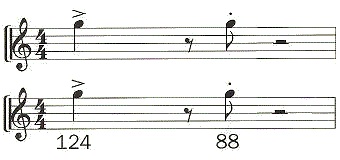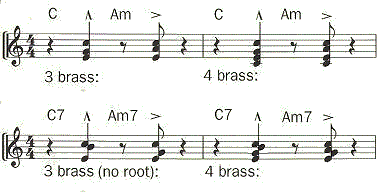In other parts brass is often used as accompaniment instruments to play riffs in each measure or in the end of a 4 measure period. These riffs can be unison or more instruments can be used.
The brass instruments have lots of dynamics, meaning they can sound very aggressive, and on the hand very soft and gentle. This has to be considered when the brass channel is programmed.
Furthermore the velocity (volume) of the voice must be set appropriately, as in last of these two examples:

Brass instruments are often used to play chords, either riffs (as the examples above) or as floating voices.
In riffs the brass voice velocity (volume) can be rather high; but when playing floating voices the best results are obtained if the velocity is more modest. Otherwise the brass instruments will dominate the accompaniment too much.
One way to create the pattern is shown as the first example below. Here we let the brass instruments play the chord notes from the highest note and downwards. Eventually setting the lowest note an octave lower than the top note.
Another way to create the pattern is shown as the next example below. Here we do as before, but we get the third or the seventh note in the pattern too.

When programming styles the most natural channel to use for brass instruments are the two Phrase channels - or the Pad channel.
However we will soon run out of output channels at the keyboard. A solution may be to use one of the "Brass section" voices.
When more brass instruments are used do not copy and paste the patterns from one instrument to the other without adding some variation. But - on the other hand - do not overdo the variation.
Avoid recognizable melodies in the phrases, as this will dictate the use of the style too much in playback.